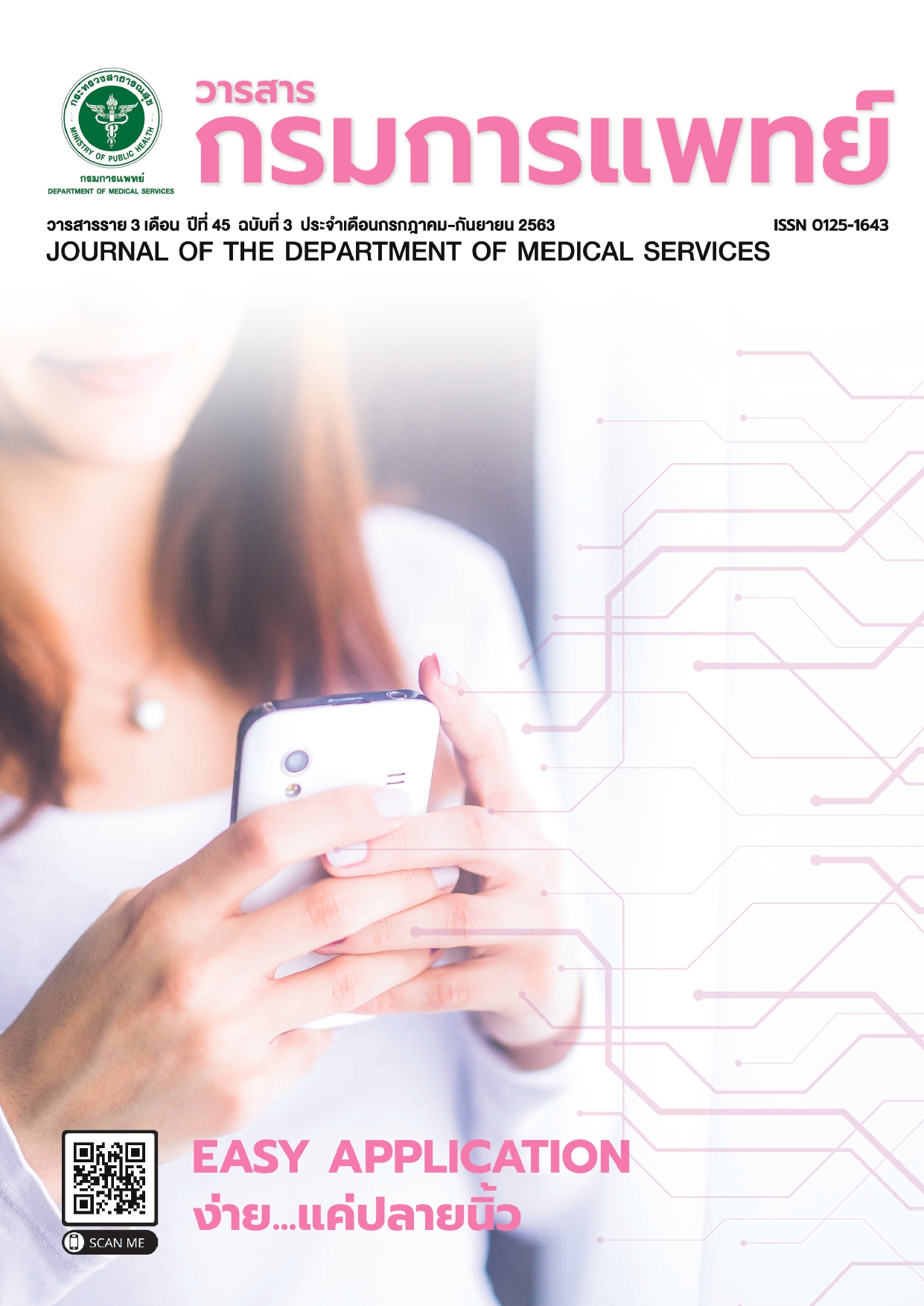การเปรียบเทียบผลการระงับปวดหลังผ่าตัดด้วยวิธี epidural analgesia และ intravenous fentanyl infusion ในผู้ป่วยเด็กสมองพิการที่มารับการผ่าตัดใหญ่ทางศัลยกรรมกระดูก
คำสำคัญ:
การระงับปวดหลังการผ่าตัด, ผู้ป่วยเด็กสมองพิการ, การผ่าตัดใหญ่ทางศัลยกรรมกระดูกบทคัดย่อ
ภูมิหลัง : การผ่าตัด pelvic varus derotation osteotomy (PVDO) และ Dega osteotomy เป็นการผ่าตัดใหญ่ทางศัลยกรรม กระดูก มีวัตถุประสงค์เพื่อรักษาภาวะข้อสะโพกเลื่อนหลุดในผู้ป่วย สมองพิการ การผ่าตัดนี้เป็นการผ่าตัดที่มีความเจ็บปวดมาก ซึ่ง ยากในการดูแลรักษา โดยเฉพาะในผู้ป่วยเด็กสมองพิการซึ่งมีข้อ จำกัดการสื่อสาร
วัตถุประสงค์ : เพื่อเปรียบเทียบประสิทธิผลใน การระงับปวด หลังการผ่าตัดระหว่างวิธี epidural analgesia และ intravenous fentanyl infusion
วิธีการ : การทดลองแบบสุ่ม มี กลุ่มควบคุม มีผู้เข้าร่วมการศึกษา 34 ราย ทุกรายได้รับการระงับ ความรู้สึกแบบทั่วไป เพื่อผ่าตัด PVDO และ Dega osteotomy ตามระเบียบวิธีวิจัยเดียวกัน ผู้ป่วย 17 ราย อยู่ในกลุ่ม intravenous fentanyl infusion (caudal block และ intravenous fentanyl infusion) และอีก 17 ราย อยู่ในกลุ่ม epidural analgesia (epidural block และ continuous epidural infusion) เก็บข้อมูล ความปวด 24 ชั่วโมงหลังการผ่าตัด โดยใช้ Non-communicative Children’s Pain Checklist Postoperative version (NCCPCPV) ผลลัพธ์คือ จำนวนผู้ป่วยที่มีความปวด (NCCPC-PV > 10) ที่ post-anesthesia care unit 8, 16, 24 ชั่วโมง การใช้ fentanyl เพื่อลดอาการปวด, pain score, parent pain scale และภาวะ แทรกซ้อนใน 24 ชั่วโมง หลังการผ่าตัด วิเคราะห์ข้อมูลด้วย MannWhitney U-Test, Pearson Chi-Square และ Fisher’s Exact Test มีนัยสำคัญทางสถิติที่ p < 0.05
ผล : ข้อมูลพื้นฐานไม่มีความ แตกต่างกันระหว่างสองกลุ่ม พบอุบัติการณ์ความปวดหลังการผ่าตัด ร้อยละ 67 และไม่แตกต่างกันทั้งสองกลุ่ม (ร้อยละ 70.6 ในกลุ่ม IV fentanyl และร้อยละ 64.7 ในกลุ่ม epidural, p = 0.71) pain score ไม่แตกต่างกันยกเว้นที่ 24 ชั่วโมงหลังการผ่าตัด (4 ในกลุ่ม IV fentanyl และ 1 ในกลุ่ม epidural, p = 0.032) ภาวะแทรกซ้อน ที่พบมากที่สุดคือ ภาวะคลื่นไส้/อาเจียนหลังการผ่าตัด (ร้อยละ 29.4 ในกลุ่ม IV fentanyl และร้อยละ 35.3 ในกลุ่ม epidural, p = 0.714) และไม่มีผู้ป่วยรายใดมีภาวะแทรกซ้อนรุนแรง
สรุป : การระงับปวดด้วยวิธี epidural analgesia สำหรับผู้ป่วยเด็กสมอง พิการที่มารับการผ่าตัดใหญ่ทางศัลยกรรมกระดูก มีจำนวนผู้ป่วย ที่มีความปวด ไม่แตกต่างกับวิธี intravenous fentanyl infusion ใน 24 ชั่วโมงแรกหลังการผ่าตัด
เอกสารอ้างอิง
Muthusamy K, Recktenwall SM, Friesen RM, Zuk J, Gralla J, Miller NH, et al. Effectiveness of an anesthetic continuous-infusiondevice in children with cerebral palsy undergoing orthopaedic surgery. J Pediatr Orthop 2010; 30:840-5.
Shrader MW, Jones J, Falk MN, White GR, Burk DR, Segal LS. Hip reconstruction is more painful than spine fusion in children with cerebral palsy. J Child Orthop 2015; 9:221-5.
Kehlet H, Holte K. Effect of postoperative analgesia on surgical outcome. Br J Anaesth 2001; 87:62-72.
Moore RP, Wester T, Sunder R, Schrock C, Park TS. Perioperative pain management in children with cerebral palsy: comparative efficacy of epidural vs systemic analgesia protocols. Pediatr Anesth 2013; 23:720-5.
Kjeldgaard Pedersen L, Nikolajsen L, Rahbek O, Uldall Duch B, Møller-Madsen B. Epidural analgesia is superior to local infiltration analgesia in children with cerebral palsy undergoing unilateral hip reconstruction. Acta Orthop. 2015; 87:176-82.
Løvstad RZ, Støen R. Postoperative epidural analgesia in children after major orthopaedic surgery. A randomised study of the effect on PONV of two anaesthetic techniques: low and high dose i.v. fentanyl and epidural infusions with and without fentanyl. Acta Anaesthesiol Scand 2001; 45:482-8.
Nolan J, Chalkiadis GA, Low J, Olesch CA, Brown TC.Anaesthesia and pain management in cerebral palsy.Anaesthesia 2000; 55:32-41.
Ohta K, Katsuno M, Kawana S, Namiki A. [Epidural opioids for post-operative pain control in pediatric patients with cerebral palsy]. Masui 1993; 42:664-8.
Peter JD, Franklyn PC, Etsuro KM. Smith’s anesthesia for infants and children. 8th ed. Mosby: Elsevier; 2011.
Kabara S, Kagawa T, Ikejima N, Takatsuji S, Sueda A. [Side Effects of Continuous Fentanyl Infusion for Postoperative Pain Relief in Children]. Masui 2015; 64:799-803.
Bernard R. Fundamentals of biostatistics (5th ed.). Duxbery: Thomson learning, 2000; 384-5.
Fleiss JL, Levin B, Paik MC. Statistical methods for rates and proportions (3rd ed.). John Wiley & Sons; 2003.
Ngamjarus C, Chongsuvivatwong V. n4Studies: Sample size and power calculations for iOS. The Royal Golden Jubilee Ph.D. Program - The Thailand Research Fund & Prince of Songkla University; 2014.
Liabsirinon S, Tantilipikorn P, Mahasup N. Interrater reliability Thai version of gross moter function classification system (GMFCS) in Thai children with cerebral palsy 2008; 1: 26-36
Breau LM, Finley GA, McGrath PJ, Camfield CS. Validation of the Non-communicating Children’s Pain ChecklistPostoperativeVersion. Anesthesiology 2002; 96:528-35.
Montalee S, Samerduen K, Wimonrat S, Duenpen H.Reliability and validity of the Thai version of noncommunicating childrens pain checklist-postoperative version (NCCPC-PV).
Johansen A, Romundstad L, Nielsen CS, Schirmer H, Stubhaug A. Persistent postsurgical pain in a general population: prevalence and predictors in the Tromsø study. Pain 2012; 153:1390-6.
Lynn MB, G. AF,Patrick JM, Carol SC.Validation of the Non-communicating Children’s Pain Checklist–Postoperative Version. Anesthesiology 2002; 96:528–35.
Heyland K, Dangel P, Gerber AC. Postoperative nausea and vomiting (PONV) in children. Eur J Pediatr Surg 1997; 7:230-3.
Naja Z, Kanawati S, Al Khatib R, Ziade F, Naja ZZ, Naja AS, et al. The effect of IV dexamethasone versus local anesthetic infiltration technique in postoperative nausea and vomiting after tonsillectomy in children: A randomized double-blind clinical trial. Int J Pediatr Otorhinolaryngol 2017; 92:21-6.
Kozek-Langenecker SA, Marhofer P, Jonas K, Macik T, Urak G, Semsroth M. Cardiovascular criteria for epidural test dosing in sevoflurane- and halothane-anesthetized children. Anesth Analg 2000; 90:579-83.
Berg MD, Schexnayder SM, Chameides L, Terry M, Donoghue A, Hickey RW, et al. Part 13: pediatric basic life support: 2010 American Heart Association Guidelines for Cardiopulmonary Resuscitation and Emergency Cardiovascular Care. Circulation 2010; 122:862-75.
ดาวน์โหลด
เผยแพร่แล้ว
รูปแบบการอ้างอิง
ฉบับ
ประเภทบทความ
สัญญาอนุญาต
บทความที่ได้รับการตีพิมพ์เป็นลิขสิทธิ์ของกรมการแพทย์ กระทรวงสาธารณสุข
ข้อความและข้อคิดเห็นต่างๆ เป็นของผู้เขียนบทความ ไม่ใช่ความเห็นของกองบรรณาธิการหรือของวารสารกรมการแพทย์



